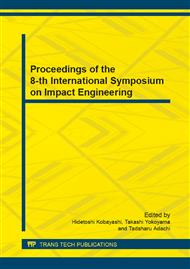p.262
p.268
p.274
p.281
p.286
p.292
p.298
p.305
p.310
Characterization of the Loading Rate Dependent Fracture Behavior over a Wide Loading Rate Range Using Charpy Specimens
Abstract:
The fracture behavior of engineering polymers is usually characterized at high loading rates using Charpy specimens. However, due to the presence of dynamic effects the conventional force based analysis for determining fracture toughness values is applicable only up to 1 m/s using tree point bending test configurations. This difficulty can be overcome in principle, by applying dynamic analysis methods (e.g. dynamic key curve (DKC) analysis) or by applying tensile loading fracture configurations. The applicability of pre-cracked Charpy specimens for determining fracture toughness values for polymeric materials over a wide loading rate range is investigated in this study.
Info:
Periodical:
Pages:
286-291
Citation:
Online since:
June 2014
Authors:
Price:
Сopyright:
© 2014 Trans Tech Publications Ltd. All Rights Reserved
Share:
Citation:


